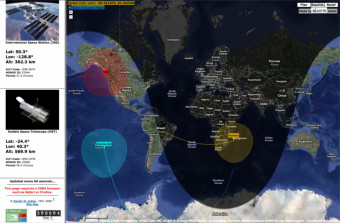 Interactive Google Maps Interactive Google Maps
|
Solar Eclipses
|
|
These interactive maps display the solar eclipses paths across the Earth’s surface. The umbral or antumbral northern and southern limits of a solar eclipse are plotted in pink while the central line is blue; non-central solar eclipses, only in polar regions, have no centerline. Navigating the maps is just like for any regular Google Maps. The drop-down menu in the top right corner turn on either a map view, a terrain view, a satellite view, a night lights or a night sky brightness view. You can append a query string to each map web page URL in order to alter the default display. The parameters can be specified in any order or can be omitted. It should look something like :
?Lat=24.4958333&Lng=17.9600000&Zoom=11&MapT='HYBRID' (example)
- Latitude is a number in decimal notation and is positive in the Northern hemisphere,
- Lng for longitude is a number in decimal notation and is positive if East of Greenwich,
- Zoom is a number between 0 and 17 specifying the zoom level (17 is highest),
- MapT is a constant specifying the map type (ROADMAP, SATELLITE, HYBRID or TERRAIN).
Other icons let you find the time-zone and terrain elevation profile, but also zoom in on a selected area, display the areas where it’s dark or else geolocate yourself.
Clicking anywhere inside the map will show the local circumstances of the eclipse at the location of the click. A "Google Map" help is available too. This animated map shows you how to embed an interactive map into your web site. The Five Millennium Canon of Solar Eclipses Database will give you access to every eclipses over the -1999 to +3000 period.
If you prefer to use Google Earth, available under MacOS X, Windows and Linux, you can download the Google Earth files (kml, kmz) for each eclipses. The best locations to observe prolonged Baily beads can be established with the help of special Google Maps showing the grazing zones. A Solar Eclipse Calculator Widget is also bound to those maps and files.
You can also create your own solar eclipses log map by visiting Solar-Eclipse.info.
Total or Hybrid Solar Eclipses
|
Please consider making a donation to support my work and show your appreciation.
These innovative maps were the first to reach the market in 2005 and have since constantly evolved to bring more added value to the visitors.
Interactive Google Map screenshot showing the track
of the March 2006 total solar eclipse.
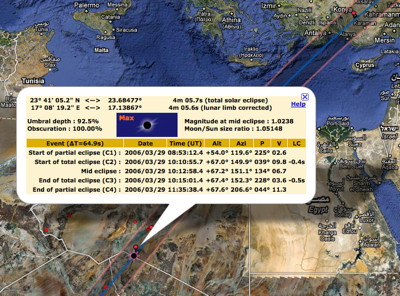
The detailed local circumstances bubble can display data,
computed on the fly, from any click location.
Lunar limb profile and Baily’s beads screenshot.

Google Earth screenshot showing the track
of the March 2006 total solar eclipse.
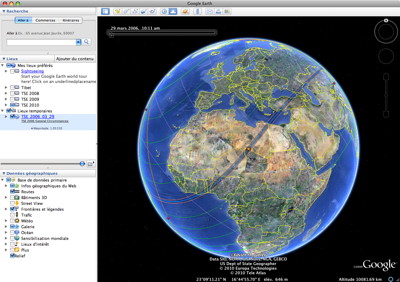
Initial view once you have done a "File -> Open".
|
|
Total on Monday, June 20, 1955
Total on Wednesday, February 15, 1961
Total on Sunday, September 22, 1968
Total on Saturday, March 7, 1970
Total on Monday, July 10, 1972
Total on Saturday, June 30, 1973
Total on Monday, February 26, 1979
Total on Friday, March 18, 1988 in the Pacific Ocean, in the Philippines or in Indonesia
Total on Sunday, July 22, 1990 in the Chukotka Okrug, Soviet Union or in Finland
Total on Thursday, July 11, 1991 in Hawaii, USA
Total on Tuesday, June 30, 1992
Total on Thursday, November 3, 1994 in Bolivia
Total on Tuesday, October 24, 1995 in India, Pakistan or Afghanistan
Total on Sunday, March 9, 1997 in Russia
Total on Thursday, February 26, 1998 in Aruba
Total on Wednesday, August 11, 1999 near Coucy-le-Chateau, France
Total on Thursday, June 21, 2001 south of Lucusse, Angola
Total on Friday, December 4, 2002 near Andamooka, Australia
Total on Sunday, November 23, 2003 in the Dronning Maud Land, Antarctica
Hybrid on Friday, April 8, 2005 in the Pacific Ocean
Total on Wednesday, March 29, 2006 in Serir Tibesti, Libya
Total on Friday, August 1st, 2008 in China, Mongolia or Russia
Total on Wednesday, July 22, 2009 in China or on Ishinomura-Kitaio Island, Japan
Total on Sunday, July 11, 2010 on Easter Island, Chile, in French Polynesia or in Argentina
Total on Wednesday, November 14, 2012 in Australia or in the Southern Pacific Ocean
Hybrid on Sunday, November 3, 2013 in Africa or airborne, over the Atlantic Ocean
Total on Friday, March 20, 2015 airborne, in Svalbard, the Faroe Islands or at the North Pole
Total on Wednesday, March 9, 2016 in Indonesia or Micronesia
Total on Monday, August 21, 2017 in the United States of America
Total on Tuesday, July 2, 2019 in Chile or Argentina
Total on Monday, December 14, 2020 in Argentina or Chile
Total on Saturday, December 4, 2021 from Union Glacier or Patriot Hills, Antarctica
Hybrid on Thursday, April 20, 2023 in Australia or Indonesia :
Total on Monday, April 8, 2024 in Mexico or the USA :
Total on Wednesday, August 12, 2026 in Iceland or Spain :
Total on Monday, August 2, 2027 in Egypt or Saudi Arabia :
Total on Saturday, July 22, 2028 in Australia
Total on Monday, November 25, 2030 in Australia
Hybrid on Friday, November 14, 2031 in the Pacific Ocean
Total on Wednesday, March 30, 2033 in Alaska
Total on Monday, March 20, 2034 in Chad or Sudan
Total on Sunday, September 2, 2035 in China or Japan
Total on Monday, July 13, 2037 in Australia
Total on Sunday, December 26, 2038 in Australia or New Zealand
Total on Thursday, December 15, 2039 in Antarctica
Total on Monday, August 21, 2017 and April 8, 2024 in the United States of America
|
Annular Solar Eclipses
Annular on Wednesday, May 30, 1984 in the United States of America
Annular on Saturday, January 4, 1992 in the United States of America
Annular on Tuesday, May 10, 1994 in the United States of America
Annular on Tuesday, February 16, 1999 in Australia
Annular on Friday, December 14, 2001 near Nosara, Costa Rica
Annular on Monday, June 10, 2002 in Mexico, Indonesia or Northern Mariana Is.
Annular on Saturday, May 31, 2003 in Greenland
Annular on Monday, October 3, 2005 near Waw an Namus, Libya
Annular on Friday, September 22, 2006 near Kourou, French Guiana
Annular on Thursday, February 7, 2008 in Ellsworth Land, Antarctica
Annular on Monday, January 26, 2009 in Indonesia
Annular on Friday, January 15, 2010 in Myanmar, Bangladesh, India or Kenya
Annular on Sunday, May 20, 2012 in the United States of America or Japan (21st)
Annular on Friday, May 10, 2013 in Australia, Solomon Is. or Kiribati
Annular on Tuesday, April 29, 2014 in Antarctica
Annular on Thursday, September 1st, 2016 in Madagascar, Tanzania or La Réunion
Annular on Sunday, February 26, 2017 in South America or Angola
Annular on Thursday, December 26, 2019 in the Arabic Peninsula or Singapore
Annular on Sunday, June 21, 2020 in Oman or India
Annular on Thursday, June 10, 2021 in Greenland, Canada or Russia
Annular on Saturday, October 14, 2023 in the United States of America or Mexico :
Annular on Wednesday, October 2, 2024 on Easter Island, Chile :
Annular on Tuesday, February 17, 2026 in Antarctica :
Annular on Saturday, February 6, 2027 in Argentina :
Annular on Wednesday, January 26, 2028 in the Galapagos
Annular on Saturday, June 1, 2030 in Siberia
Annular on Wednesday, May 21, 2031
Annular on Wednesday, May 9, 2032
Annular on Tuesday, September 12, 2034
Annular on Friday, March 9, 2035
Annular on Tuesday, January 5, 2038
Annular on Friday, July 2, 2038
Annular on Tuesday, June 21, 2039
|
Recent and Coming Partial Solar Eclipses
Partial on Tuesday, January 4, 2011
Partial on Wednesday, June 1st, 2011
Partial on Friday, July 1st, 2011
Partial on Friday, November 25, 2011
Partial on Thursday, October 23, 2014
Partial on Sunday, September 13, 2015
Partial on Thursday, February 15, 2018
Partial on Friday, July 13, 2018
Partial on Saturday, August 11, 2018
Partial on Sunday, January 6, 2019
Partial on Saturday, April 30, 2022
Partial on Tuesday, October 25, 2022
Partial on Saturday, March 29, 2025
Partial on Sunday, September 21, 2025
Partial on Sunday, January 14, 2029
Partial on Tueday, June 12, 2029
Partial on Wednesday, July 11, 2029
Partial on Wednesday, December 5, 2029
|
|
|
|
Geolocation Auto-Tracking for Solar Eclipses
|
|
How to optimize your position using your smartphone and know in real-time how good you’re doing in terms of position in relation to the totality path you can use this auto-tracking geolocation tool
http://xjubier.free.fr/en/site_pages/solar_eclipses/TSE_2016_GoogleMapFull.html?Map=ROADMAP
or a more complex map (all the URL on one single line with no spaces)
http://xjubier.free.fr/en/site_pages/solar_eclipses/xSE_GoogleMap3.php?Ecl=+20160309&Acc=2&Umb=1&Lmt=1&Mag=1&Max=1&MapT=ROADMAP
Remove the ?Map=ROADMAP at the end of the URL if you want to stay in the default SATELLITE mode. Of course the map mode can still be selected once the map is loaded. And the road traffic can be displayed as well.
The tool has been tested with success on a variety of devices from iOS to Android, Windows Phone and Blackberry. Nevertheless please report any problem you may encounter and don’t forget to provide a screenshot and a detailed description.
Then to activate the tool click on the lower icon on the left side, the one looking like a blueish shooting target  . Once activated you should be prompted to accept being geolocated, so answer positively and the map should center on your current position and track your movements (it will work as well on a desktop computer connected via an Ethernet cable and even better via Wi-Fi). To deactivate the tool and stop the tracking click again on the button. . Once activated you should be prompted to accept being geolocated, so answer positively and the map should center on your current position and track your movements (it will work as well on a desktop computer connected via an Ethernet cable and even better via Wi-Fi). To deactivate the tool and stop the tracking click again on the button.
Depending on your device you may have to authorize geolocation in the general settings as well. For example on iOS or OSX you should do so in the privacy settings.
The detailed circumstances bubble is disabled while the auto-tracking geolocation is activated in order not to clutter the screen too much.
More there
http://xjubier.free.fr/en/site_pages/solar_eclipses/xSE_GoogleMap3_Help.html#geolocation.
|

Auto-tracking geolocation tool in action
|
|
Satellites and Spacecraft
|
|
Each satellite will trail an orbital tracking line as it moves through its orbit, so leave the page open to follow along and see its range. Your browser will check once per minute for new data culled from the NASA site.
|
|
The attendance rises sharply for the 2015th March 20 total solar eclipse with a peak of more than 230,000 daily visitors on March 19.
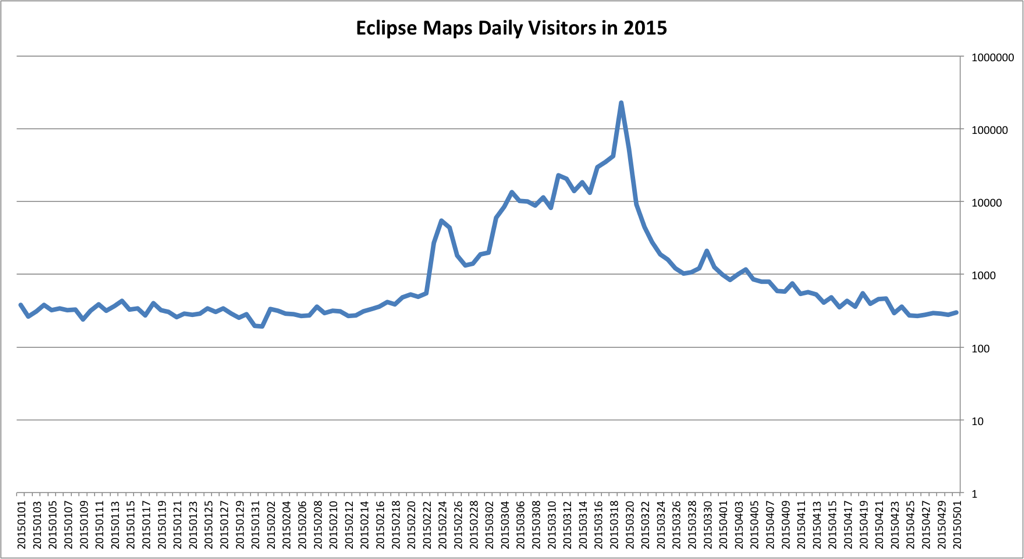
And now for the record-breaking 2017 August 21st total solar eclipse with a peak of more than 13,000,000 daily visitors on August 21st. Sadly I haven’t saved the data past August 19th, yet the 19th is already above five millions and over the month of August 2017 the total number of visitors came above 100 millions.
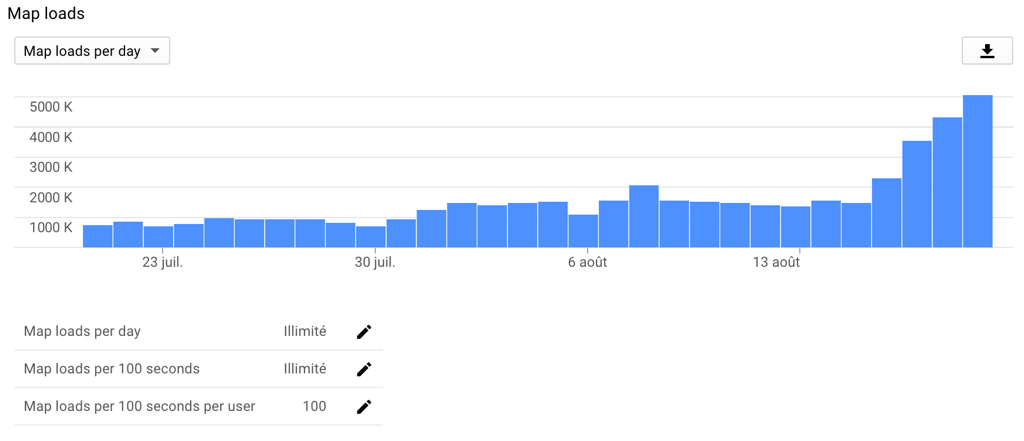
|
|
|
|


 Interactive Google Maps
Interactive Google Maps





